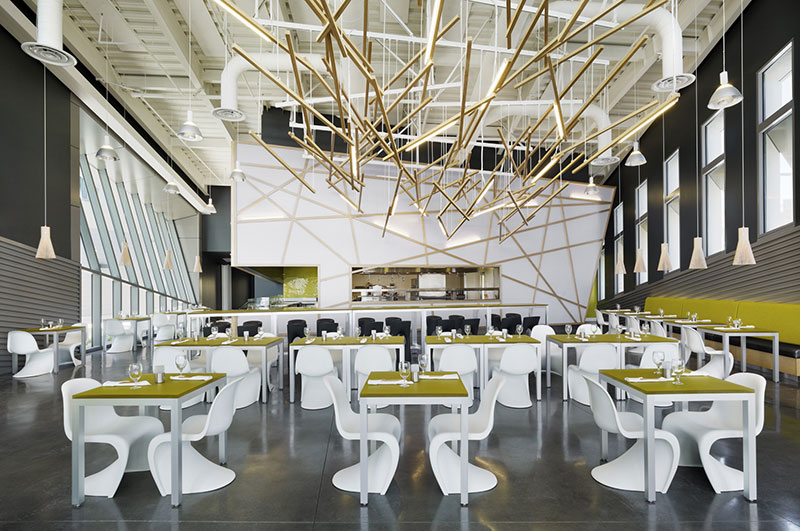The opinions expressed in this commentary are solely those of the author and do not necessarily reflect those of the National Council of Architectural Registration Boards (NCARB).
The multidisciplinary design practice has been a successful model for decades, usually involving a mix of architects, planners, interior designers, engineers, visual artists, and other creative professionals. In recent years, we’re seeing a growth in firms that work across design disciplines for a new reason—to help their clients express their authenticity, innovate rapidly, and elevate their brand. This trend marks the triumph of design thinking as a hallmark of both creativity and market-based success.
Dimensional Branding
Architecture firms can and should emulate these multidisciplinary models. It begins by identifying the design challenges that most distinguish (or frustrate) our clients—their unique brand—and then applying the architect’s mindset in the broadest way possible.

That’s why our firm started looking for a way to integrate corporate culture branding and visual identity with interiors and architecture, beginning about a decade ago. We coined the term “dimensional branding” to describe how an organization’s identity and mission could be expressed not only in a logotype and marketing materials, but also in three-dimensional space and built form. In 2007, Carrier Johnson acquired a graphics and corporate branding agency and then rolled out our new dimensional brand unit called CULTURE.
At the time, this move was widely reported and the subject of numerous presentations and articles in business magazines and architecture journals. A few other firms were known for their experiential branding or “branded environments,” including Gensler in Washington, DC, and Perkins+Will in Chicago. Others, like March Studio in Santa Monica, were established specifically for this aim. Still, for us it was a big investment, and we believed it would pay off.
High Impact Innovation
With our new name, Carrier Johnson + CULTURE, we began a firm-wide client engagement and project delivery reinvention that integrated branding into architectural practice. A wonderful benefit of this approach was how it opened doors to high-level strategy sessions with our clients. By focusing on design thinking, our multidisciplinary approach also helped build consistent design ideas across all scales and types of expression. Best of all, it led to high-impact innovation for corporate, public works, university, and developer clients alike.

Since we started CULTURE in 2007, other firms have embraced the benefits of design thinking. Examples include Hickok Cole Architects in Washington, DC, which recently launched a full-service advertising agency within its walls. Another is Streetsense, a Maryland-based studio known for integrating architecture, interiors, and planning along with original market research, real estate brokerage and development, and even food and beverage consulting. (They handle branding and marketing, too.) Both firms were recently noted in the AIA Forecast Report [PDF].
There are a number of reasons to consider expanding your practice in this way, but the most important is design innovation. By taking on some of these other disciplines, architect-led practices will enjoy increased engagement with clients and key stakeholders, working more closely with the people who drive organizational mission and growth—as opposed to just facilities or procurement managers, who are often tasked solely with cutting costs. Executed properly, the multidisciplinary approach should also expand your client base and drive up billings.
“Infusing Culture Into Architecture”
So what do the results look like? Some of our favorite dimensional branding projects involved major architecture commissions, like The Village at Torrey Pines East at University of California, San Diego, a 238,000-square-foot “branded village” of student housing. Another is DiamondView Tower, a $53 million, mixed-use office complex that overlooks Petco Park, home of the San Diego Padres, with monumental graphics and ballpark-inspired architectural elements. Another project, the Hard Rock Hotel Complex in the Gaslamp Quarter in San Diego, delivers brand-focused architecture and urban revitalization for a client with focused brand-management needs.

We hope our approach can serve as a model for firms nationally, which has been widely championed by Michael C. Johnson, AIA, NCARB, the managing partner of Carrier Johnson + CULTURE. Architect magazine wrote about our “new revenue streams” and other reasons “architects are adding graphic artists and marketing gurus.” One radio show touted how our new approach is “infusing culture into architecture.”
While we’re always happy to receive accolades, we ultimately evolved our practice to flex our design muscles and encourage innovation. If you feel the same way, consider your clients’ core needs. Explore if you too can adapt your practice to include a more integrated, multidisciplinary approach. I can promise one thing: The world needs it.
Gordon Carrier, FAIA, NCARB, is founding design principal at Carrier Johnson + CULTURE, a leading global architecture, design, and strategic branding practice known for innovative building, living, and communications solutions, reflecting the unique three-dimensional brand opportunities for each situation.
